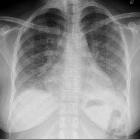enlarged cisterna magna









Mega cisterna magna refers to a normal variant characterized by a truly focal enlargement of the CSF-filled subarachnoid space in the inferior and posterior portions of the posterior cranial fossa. It is an incidental finding on neuroimaging, and no imaging follow up is necessary.
Epidemiology
A mega cisterna magna is thought to occur in ~1% of all brains imaged postnatally. It constitutes 54% of all cystic posterior fossa malformations .
Associations
Especially if noted antenatally, a mega cisterna magna has been associated with:
- infarction
- inflammation/infection: particularly cytomegalovirus
- chromosomal abnormalities: especially trisomy 18
However, when a mega cisterna magna occurs as an isolated finding with normal ventricles, the prognosis is good.
Clinical presentation
There are no specific symptoms related to this condition.
Pathology
Some authors have proposed that mega cisterna magna is a result of a delayed Blake pouch fenestration; when fenestration does not occur, it results in a Blake pouch cyst .
Radiographic features
Ultrasound
On antenatal ultrasound, mega cisterna magna refers to an enlarged retrocerebellar CSF space:
- usually >10 mm (some consider up to 12 mm within normal limits)
- septa may be seen within a mega cisterna magna, which are thought to be Blake pouch vestigial remnants
- the vermis should be closely evaluated to exclude Dandy-Walker continuum abnormalities
CT/MRI
Typically seen as prominent retrocerebellar cerebrospinal fluid (CSF) appearing space with a normal vermis, normal 4 ventricle, and normal cerebellar hemispheres. An enlarged cisterna magna usually measures >10 mm on midsagittal images. An enlarged posterior fossa can sometimes be present .
History and etymology
The term was coined by the Belgian neurosurgeon Richard Gonsette (1929-2014) in 1962, in patients with cerebellar atrophy .
Differential diagnosis
Mega cisterna magna needs to be distinguished from other causes of an enlarged retrocerebellar CSF space:
- arachnoid cyst
- epidermoid cyst: often shows a heterogeneous/dirty signal on FLAIR and restricted diffusion
- cerebellar atrophy / cerebellar hypoplasia
- Dandy-Walker malformation: vermis not intact
- Blake pouch cyst: usually hydrocephalus is present
- pilocytic astrocytoma: if very posterior and predominantly cystic; should contain a mural nodule
Siehe auch:
- Arachnoidalzysten der hinteren Schädelgrube
- Kleinhirnatrophie
- Blake's-Pouch-Zyste
- epidermale Inklusionszyste
- zystische Raumforderung hintere Schädelgrube
- Dandy-Walker-Syndrom
- Kleinhirnhypoplasie
- zerebelläre Anomalien
- Zytomegalievirus
- zystische Malformationen der hinteren Schädelgrube
- zystische zerebelläre Raumforderungen
- erweiterter retrocerebellärer Liquorraum
und weiter:
- Arachnoidalzyste
- Cisterna cerebellomedullaris
- Blake’s pouch
- Pätau-Syndrom
- intrakranielle Epidermoidzyste
- obstetric curriculum
- Dandy-Walker continuum
- intraventricular epidermoid
- fetal intra-cranial cystic lesions
- Joubert-Syndrom
- sonographic values in obstetrics and gynaecology
- differential diagnosis of intracranial cysts in the perinatal period
- soft antenatal markers on ultrasound
- einseitige Kleinhirnaplasie
- unilateral cerebellar hypoplasia
- Backenzahn-Zeichen (ZNS)
- fetal MRI in holoprosencephaly and mega cisterna magna

 Assoziationen und Differentialdiagnosen zu Mega Cisterna magna:
Assoziationen und Differentialdiagnosen zu Mega Cisterna magna:









